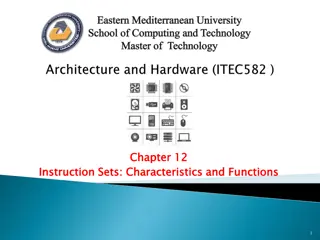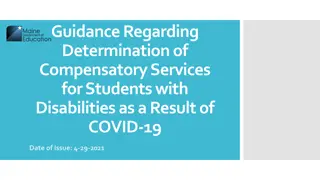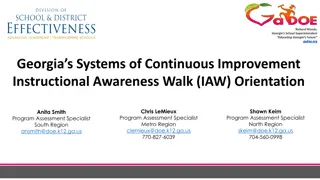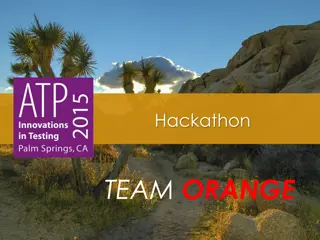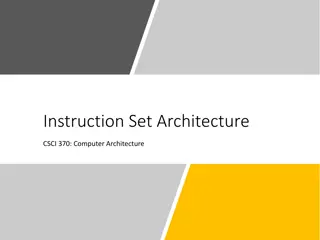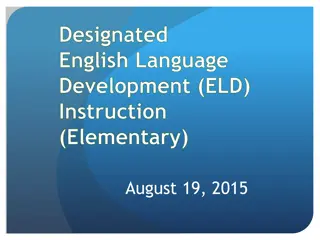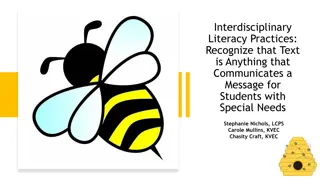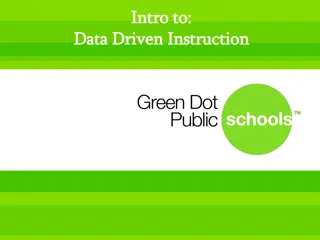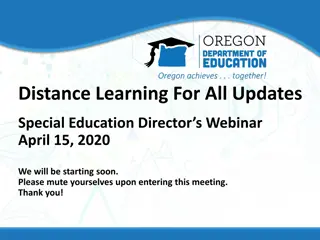Effective Strategies for Home Learning: Specially Designed Instruction
Discover how to define and implement Specially Designed Instruction (SDI) for home learning, including understanding different types of SDI, navigating changes to your child's Individualized Education Program (IEP), and communicating efficiently with school teams. Learn about educational rights, expectations, and strategies tailored to facilitating learning at home effectively, emphasizing the importance of collaboration between families and schools.
Download Presentation

Please find below an Image/Link to download the presentation.
The content on the website is provided AS IS for your information and personal use only. It may not be sold, licensed, or shared on other websites without obtaining consent from the author.If you encounter any issues during the download, it is possible that the publisher has removed the file from their server.
You are allowed to download the files provided on this website for personal or commercial use, subject to the condition that they are used lawfully. All files are the property of their respective owners.
The content on the website is provided AS IS for your information and personal use only. It may not be sold, licensed, or shared on other websites without obtaining consent from the author.
E N D
Presentation Transcript
SPECIALLY DESIGNED INSTRUCTION FOR LEARNING AT HOME APRIL 16, 2020 12:00 PM AND 7:00 PM
Interact with us - Guidelines If you have a question that you would like answered, type it into the Question pane. We will respond during the webinar to those that we are able to or afterward We may have to reach out and get answers from partners If you have information or resources you want to share with everyone, type them into the chat box and chat to everyone We will also periodically be asking you to respond to polls during the webinar these questions are primarily targeted to the family members who are participating today. Let s start with a quick poll to see who has joined us
Participants will be able to: Define Specially Designed Instruction (SDI) Describe types of SDI Identify potential changes to the SDI in your child s IEP Create a plan for discussing needed changes with your school team
Statement from Bureau of Special Education It is PDE s expectation that all LEAs are providing planned instruction through a Continuity of Education Plan and FAPE is provided to students with disabilities to the greatest extent possible which is reasonable and appropriate in light of the circumstances. All school entities are required to submit a Continuity of Education plan. We are monitoring the submissions and the majority have already submitted plans. We will be following up with any district that does not submit a plan. We are attending LEA special education leadership meetings across the state over the few weeks to provide emphasis to our guidance. 5 Things to Know: PDF from Ed Law Center-handout PDE Guidance
Important Points to Remember Families are facilitating learning, not responsible for delivering instruction IEP team must consider the ability and needs of the family as they plan for instruction to be facilitated at home Make a good faith effort
Important Points to Remember Supreme Court Justice Roberts writes, The IDEA demands more. It requires an educational program reasonably calculated to enable a child to make progress appropriate in the light of the child s circumstances. To be clear, the term circumstances applies to the child s ability and potential not to the closure of schools due to the pandemic.
Important Points to Remember When you have an IEP meeting to address the interim special education services, these sections of the IEP are most important: Goals, Progress Monitoring SDI Notice of Recommended Educational Placement/Prior Written Notice (NOREP/PWN)
Suggestions for Ongoing Success Make note of the school district s solutions to moving from a brick and mortar setting to a virtual one. Feel welcome to offer creative solutions and brainstorm with the school to come up with SDI that will work in a virtual setting. Have a plan to present your child s needs and your creative ideas to the others on the IEP team.
Annotated IEP Specially Designed Instruction
Special Education = Specially Designed Instruction
Specially Designed Instruction adapting the content, methodology, or delivery of instruction to address the unique needs of the child that result from the child s disability, and to ensure access of the child to the general curriculum Most SDI falls into two categories: Accommodations - Changes how the child learns Modifications Changes in what a student is expected to learn changes in instructional level, content, and performance criteria
Examples Accommodations Modifications Listening to an audio version of a book Viewing a video about a science concept Using a keyboard to write Extra time to complete tests or assignments Enlarged text Complete different homework than peers Learn only the big ideas of a science lesson Graded or assessed using a different standard than others
Access to Instructional Materials Access to written materials must be provided to students who have print disabilities at the same time as peers receive them Access can be provided via: Alternate accessible formats (e.g., on a computer with screen reader software) Specialized formats (e.g. Braille, audio, large-print, etc.)
Supplementary Aids and Services Aids, services, and other supports Provided in regular education classes, other education-related settings, and in extracurricular and nonacademic settings To enable students with disabilities to be educated with nondisabled students to the maximum extent appropriate Purpose is to support students with disabilities as active participants with nondisabled peers as well as to enable their access to the general curriculum.
Supplementary aids and services should be: Available to all students who need them Designed to provide meaningful educational benefit Provided in a manner that avoids stigmatizing students
Access to the General Education Curriculum Providing students with disabilities the right to the same state, district and school curriculum that is provided to students without disabilities Supplementary Aids and Services and SDI help to ensure successful inclusive education
Types of SDI Environmental/Physical Organizational Testing and Assignments Instructional Behavioral Social Collaborative 1. 2. 3. 4. 5. 6. 7.
1. Environmental/Physical Adaptations and modifications to the physical environment Provided when school buildings are open: Adaptive equipment Low tech: adapted paper, slantboard, special seating, wedges High tech: FM systems, Computer, iPad, Wi-Fi (hot spots), online platforms Possible virtual support: IEP team assists the family to create a virtual learning environment that meets the student s needs
2. Organizational Supports and instruction teach students to plan, organize and execute tasks Provided when school buildings are open: Check in and check out with teacher(s) Possible Virtual SDI: Individualized 3 minute instant message by teacher 5 minute alarm check in pop up Agenda prompts link schedule reminders to a child s calendar
3. Testing and Assignments Accommodations of where and duration; modification of work Provided when school buildings are open: Extended time Possible Virtual SDI No change may be needed because extended time can still be provided but expectations need to be clear to the child and the family
4. Instructional Development and delivery of instruction that addresses diverse learning needs Provided when school buildings are open: Modified Instruction use of evidence-based multi-sensory reading intervention Possible Virtual SDI: Identify an evidence-based intervention that can be delivered through distance learning
5. Behavioral Supports and services to increase appropriate behavior and reduce disruptive or interfering behavior Provided when school buildings are open: Modification of rules and expectations Possible Virtual SDI: IEP team (which always includes the family) reviews the Behavioral Support Plan to identify how it can be provided at home and provide training/coaching to family on implementing strategies
6. Social Supports and services to increase appropriate social skills and/or emotional regulation Provided when school buildings are open: Social skills instruction Possible Virtual SDI Facilitate video modeling at home and small group virtual conversations
7. Collaborative Adults working together to support students Provided when school buildings are open: Scheduled opportunities for parental collaboration Possible Virtual SDI Scheduled coaching and guided support for team members to plan and problem-solve for an individual student
Students can have a new approach to be active participants in this process, be self-aware of both their abilities and areas in which they struggle, be able to self-advocate and state their needs to the adults responsible for creating and providing the programs and services, be able to provide feedback throughout their education so revisions can be made to the programs and supports as necessary. Michigan Virtual University
Resources Deschaine, M. (2018). Supporting students with disabilities in k-12 online and blended learning. Lansing, MI: Michigan Virtual University. Retrieved from https://mvlri.org/research/publications/suppo rting-students-with-disabilities-in-k-12-online-and- blended-learning/ Accomodations and Modifications for more information
Evaluations You will get an email in 1 hour with the link to complete the Webinar Evaluation. We have received wonderful feedback from previous evaluations. Please share any comments or questions, as we read them all! If you don t want to wait an hour, the link is: www.surveymonkey.com/r/PEALwebinareval
Thank You! www.pealcenter.org info@pealcenter.org 1-866-950-1040 Serving families across PA with offices in Pittsburgh and Philadelphia





